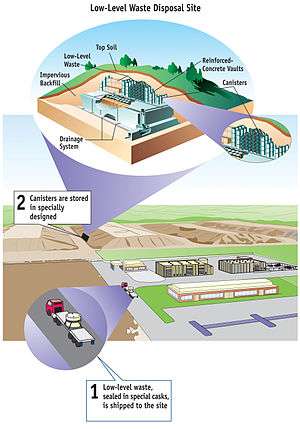Low-level waste

Low-level waste (LLW) is nuclear waste that does not fit into the categorical definitions for intermediate-level waste (ILW), high-level waste (HLW), spent nuclear fuel (SNF), transuranic waste (TRU), or certain byproduct materials known as 11e(2) wastes, such as uranium mill tailings. In essence, it is a definition by exclusion, and LLW is that category of radioactive wastes that do not fit into the other categories. If LLW is mixed with hazardous wastes, then it has a special status as mixed low-level waste (MLLW) and must satisfy treatment, storage, and disposal regulations both as LLW and as hazardous waste. While the bulk of LLW is not highly radioactive, the definition of LLW does not include references to its activity, and some LLW may be quite radioactive, as in the case of radioactive sources used in industry and medicine.
The definition of low-level waste is set by the nuclear regulators of individual countries, though the International Atomic Energy Agency (IAEA) provides recommendations.[1] Some countries, such as France, specify categories for long-lived low- and intermediate-level waste. U.S. regulations do not define the category of intermediate-level waste.
Disposal

Depending on who "owns" the waste, its handling and disposal is regulated differently. All nuclear facilities, whether they are a utility or a disposal site, have to comply with Nuclear Regulatory Commission (NRC) regulations. The four low-level waste facilities in the U.S. are Barnwell, South Carolina; Richland, Washington; Clive, Utah; and as of June 2013, Andrews County, Texas.[2][3] The Barnwell and the Clive locations are operated by EnergySolutions, the Richland location is operated by U.S. Ecology, and the Andrews County location is operated by Waste Control Specialists. Barnwell, Richland, and Andrews County accept Classes A through C of low-level waste, whereas Clive only accepts Class A LLW. The DOE has dozens of LLW sites under management. The largest of these exist at DOE Reservations around the country (e.g. the Hanford Reservation, Savannah River Site, Nevada Test Site, Los Alamos National Laboratory, Oak Ridge National Laboratory, Idaho National Laboratory, to name the most significant).
Classes of wastes are detailed in 10 C.F.R. § 61.55 Waste Classification enforced by the Nuclear Regulatory Commission, reproduced in the table below. These are not all the isotopes disposed of at these facilities, just the ones that are of most concern for the long-term monitoring of the sites. Waste is divided into three classes, A through C, where A is the least radioactive and C is the most radioactive. Class A LLW is able to be deposited near the surface, whereas Classes B and C LLW have to be buried progressively deeper.
In 10 C.F.R. § 20.2002, the NRC reserves the right to grant a free release of radioactive waste. The overall activity of such a disposal cannot exceed 1 mrem/yr and the NRC regards requests on a case-by-case basis. Low-level waste passing such strict regulations is then disposed of in a landfill with other garbage. Items allowed to be diposed of in this way are: glow-in-the-dark watches (radium) and smoke detectors (americium) among other things.
| Radionuclide | Class A (Curies/m3) | Class B (Ci/m3) | Class C (Ci/m3) |
|---|---|---|---|
| Total of all nuclides with less than 5 year half life | 700 | No limit | No limit |
| Tritium (3H) | 40 | No limit | No limit |
| Cobalt-60 (60Co) | 700 | No limit | No limit |
| Nickel-63 (63Ni) | 3.5 | 70 | 700 |
| Ni-63 in activated metal | 35 | 700 | 7000 |
| Strontium-90 (90Sr) | 0.04 | 150 | 7000 |
| Cesium-137(137Cs]] | 1 | 44 | 4600 |
| Carbon-14(14C) | 0.8 | 8 | |
| C-14 in activated metal | 8 | 80 | |
| Nickel-59 (59Ni) in activated metal | 22 | 220 | |
| Niobium-94 (94Nb) in activated metal | 0.02 | 0.2 | |
| Technetium-99 (99Tc) | 0.3 | 3 | |
| Iodine-129 (129I) | 0.008 | 0.08 | |
| Alpha emitting transuranic nuclides with a half life greater than 5 years |
10 nCi/g | 100 nCi/g | |
| Plutonium-241 (241Pu) | 350 nCi/g | 3500 nCi/g | |
| Curium-242 (242Cm) | 2000 nCi/g | 20000 nCi/g |
LLW should not be confused with high-level waste (HLW) or spent nuclear fuel (SNF). C Class low level waste has a limit of 100 nano-Curies per gram of alpha-emitting transuranic nuclides with a half life greater than 5 years; any more than 100 nCi, and it must be classified as transuranic waste (TRU). These require different disposal pathways. TRU wastes from the U.S. nuclear weapons complex is currently disposed at the Waste Isolation Pilot Plant (WIPP) near Carlsbad, New Mexico, though other sites also are being considered for on-site disposal of particularly difficult to manage TRU wastes.
See also
References
Notes
- ↑ "Classification of Radioactive Waste : a Safety Guide. Safety Series No. 111-G-1.1" (PDF). RADWASS Programme. Vienna: IAEA. 1994. Retrieved 25 July 2009.
- ↑ "Disposal of Commercial Low-Level Radioactive Waste". Nuclear Energy Institute. April 2014. Retrieved May 8, 2015.
- ↑ "New Federal Waste Facility Opens with Ribbon Cutting Ceremony" (PDF). Waste Control Specialists. June 6, 2013. Archived from the original (PDF) on 23 May 2014. Retrieved May 9, 2015.
General references
- Fentiman, Audeen W. and James H. Saling. Radioactive Waste Management. New York: Taylor & Francis, 2002. Second ed.
- Jorge L. Contreras, "In the Village Square: Risk Misperception and Decisionmaking in the Regulation of Low-Level Radioactive Waste", 19 Ecology Law Quarterly 481 (1992) (SSRN)